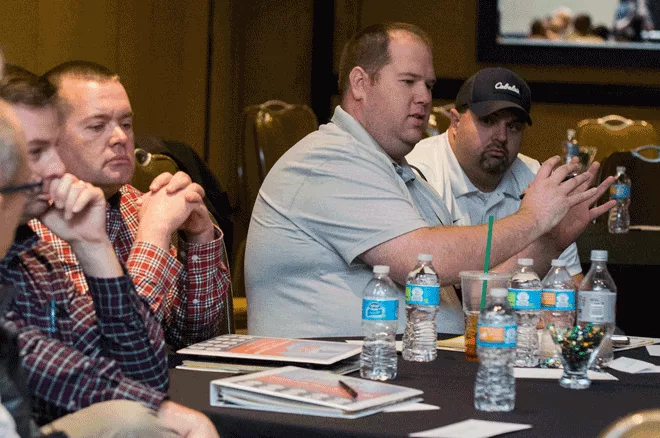A Precision Farming Dealer Staff Report
Moderated by John Schmeiser, CEO, Western Equipment Dealers Assn., the roundtable on lessons learned from the recent tough times received good and candid participation from dealers of many types, colors and sizes throughout North America.
General Business
“The consensus of the group was that the small ag business and precision ag business was at least similar or up from the previous year,” Schmeiser says. “The concern is big ag, but it differed regionally as well.”
For instance, several of the Western Canadian dealers indicated that they faced 2 years earlier what their U.S. brethren was facing; that the U.S. was lagging the downturn already faced to their northern neighbors. “Some of the dealers in the session who’d been hurt on the loss of cash flow in big ag felt like they and their farmers had gotten through it and turned the corner, while others, like here in Missouri, may be just in the middle of it now,” Schmeiser says.
While some analysts had projected a return to pre-2013 levels at the end of 2017, Schmeiser says that the consensus of the roundtable in St. Louis was that it was going to take longer than that.
Trades
Virtually every dealer who spoke could point to some deals they wished they’d been more selective about, including the large multi-unit deals. “Some were taken to satisfy manufacturers’ concern on market share,” Schmeiser says.
The group talked about various responses for increasing used inventory levels. Interestingly, one dealer discussed how his group was preparing itself for a blow-out sale through an auction and caught a break. A quick turn of the weather brought some equipment sales, and his group had inventory to sell when its competitors, who reacted more quickly to ridding it from their lots, did not.
While no one was celebrating the market conditions, several indicated that even a flat year would yield much better results for the dealerships. “Our carryover is 25% less now that it was in 2016,” said one dealer. “So, while the pressure is still there to do deals, we’re in better shape and also buying today at a much better value.”
Parts & Service Sales—Shouldn’t It Go Up?
“With slowdown in big ag, conventional wisdom is parts and service sales should go up,” says Schmeiser. “But the fact of the matter is, dealers say that today’s equipment is taking a lot longer to wear down, more so than in the past.” The group’s consensus was that the manufacturers’ argument for increased parts and service sales during a downturn is not realistic and that the assumption that it’ll come naturally with a downturn in new wholegoods is false. But the dealers did state that more opportunities can be found through a tight integration with precision ag and service technicians, both of who are well trusted by the farmer and not viewed as salespeople.
Reinvestment During a Downturn
Schmeiser asked questions about reinvesting during difficult times. The consensus was if you’re in the business long term, the investment in your facility is good decision. “When new sales go down, there is more opportunity to compete on the service side,” said one, also noting the larger equipment today. “You can get the return on the investments in your shop, in your service vehicles. If the dealer has the financials, now is the time to do it, because no one wants to ‘interrupt’ sales later for these things.” Another says, “We ask our customers to buy during downturns, so we need to show the same commitment and not just wait on things that the business needs.”
Adding a new product line to the basket as a strategy to endure tough times didn’t gain as good of a reception, though one noted that the precision ag business was a godsend for creating sales and the incremental steps toward better equipment and technology.
While several had taken on new lines, including a new specialized tractor, the decision to add product requires more thought than to “just have something more to sell.” It depends on the capability and knowledge of a dealer’s current staff, which was something many of the dealers saw as the limiting factor. “If you have top-notch and knowledgeable people, it can be an option, but your core business can also suffer and you can lose sales by chasing and learning about a new product,” says one dealer.
Good to Great
Heads were nodding in agreement with the sharing of the following mantra. “Do a good business in the tough times, and you’ll do a great business in the good times.”
At the conclusion of his recap at the general session, Schmeiser advised dealers to watch trades, watch cash flow and pay attention to interest rates
Read full coverage of the Precision Farming Dealer Summit presentations, from how to recruit and retain precision employees, to developing a standalone precision business, to managing customers’ data, in the March 2017 issue of Farm Equipment.
Roundtable Discussion Topics
1. Precision Peer Groups: Your External Support Network
2. Tips, Tricks & Tactics for Selling Data Management Service
3. Does My Precision Ag Business Need to Have a CRM?
4. Putting on a Successful Precision Ag Field Day
5. Market Corrections: Lessons Learned During the Downturn (currently viewing)
6. UAVs: Ready for Takeoff? Or a Grounded Technology?
7. Aftermarket Opportunities: What am I Missing?
8. Where Can I Find My Next Precision Hire?
9. Bundling Service: What to Include & How to Price
10. Better Advice for Selling RTK Subscriptions
11. Probing the Moisture Sensor & Water Management Market
12. 7 Considerations for Succession Planning for a Precision Farming Business
13. Autonomy in Ag: What Role Will I Play?
14. Bridging the Hardware Gap: Adding Agronomic Services



![[Technology Corner] A Big Step Forward for Interoperability & Data Sharing](https://www.precisionfarmingdealer.com/ext/resources/2025/12/12/A-Big-Step-Forward-for-Interoperability--Data-Sharing.webp?height=290&t=1765565632&width=400)


